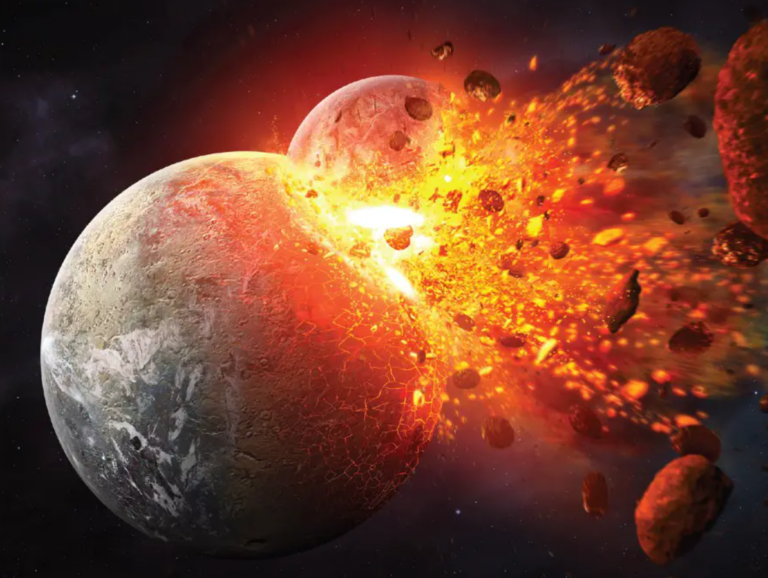Moon-forming impacts may be hidden deep within Earth’s interior
Throughout their childhood, Earth and Theia lived in harmony but everything changed when gravitational disturbances attacked
Very recently, the scientists held a theory that these so-called large low-shear velocity provinces or LLSVPs were simply the expressions and remnant objects of the colossal protoplanet Theia, which crashed with the Earth four and a half billion years ago to create the Moon. These formations are situated beneath West Africa and the Pacific Ocean; they are distinct and have greater density than the surrounding mantle. Using newer seismic and isotopic data, researchers are studying whether any trace of the opaque material Theia may have survived as the mantle of Theia down-well below the Earth surface. If subsequent studies are able to qualitatively confirm the evidence, this finding could entirely reshape the geological perspective on the structure and formative history of our planet.
For a long time, scientists have agreed that the Moon formed after a protoplanet named Theia collided with the early Earth at about 4.5 billion years ago. Now such researchers support a bold new idea, that the last real remains of Theia survived and are hidden within two massive rock layers under Earth’s mantle.
No serious scientist today could disagree that these two superstructures-a kind of headphones encircling Earth’s center- existed beneath West Africa and the Pacific Ocean. They may tower as high as 1,000 kilometers and extend for several thousand kilometers across almost the entire planet. “They are the largest features in Earth’s mantle,” Qian Yuan, a Ph.D. student headed for geodynamics with Arizona State University, assured me. Seismic waves from earthquakes slow down significantly when moving through any of those layers. The only reasonable supposition is that they are denser, not to mention chemically distinct.
These LLSVPs might have formed from Earth’s ancient magma ocean or be dense remnants of the primitive mantle that survived the Moon-forming impact. However, Yuan, based on isotopic data and models, hypothesizes these structures could be remnants of Theia. “This wild idea is at least plausible,” says Yuan, who presented the hypothesis at the Lunar and Planetary Science Conference.
It has circulated for years, but Edward Garnero, a seismologist at ASU not involved in the study, believes this is the first substantial evidence that has been gathered. “I think it’s possible until proven otherwise.”
Evidence from Iceland and Samoa has supported the view that these LLSVPs have been around since the Moon-forming event, says Sujoy Mukhopadhyay, a geochemist at UC Davis. Volcanic eruptions occurring in these regions have been associated with arrivals of magma plumes sourced in the genesis of the LLSVPs, and lava from the volcanoes has also preserved isotopic tracks from the first hundred million years of Earth’s history.
The most recent studies on the Moon-forming impactor suggest that it deposited dense material deep inside Earth. The impact theory, first proposed in the 1970s, explained why the Moon lacks significant water and has a small iron core: a massive collision would have vaporized water and formed the Moon from lighter debris. Earlier models suggested the impactor was Mars-sized, but Desch’s work now suggests that Theia was very nearly Earth-sized.
Some studies done by Desch and co-workers of the Apollo Moon rocks showed that some Moon materials had much higher ratios of light hydrogen (hydrogen-to-deuterium) than Earth rocks, which lead to the conclusion that Theia was a highly massive dry protoplanet. It therefore implies that its mantle was well denser than that of Earth; perhaps 2% to 3.5% more dense, which drove it down into Earth’s mantle after the collision.
The simulations performed by Yuan on Theia’s mantle confirmed that a material of 1.5%-3.5% density over that of Earth could have survived the setting which gathered near inner Earth. This is something Desch concurs with.”It’s the perfect density range,” he notes.
A massive Theia could well explain the size of LLSVPs, six times the mass of the moon. Yuan noted that only a Theia-sized impactor could plausibly account for them.
But this is not the entire picture. Some researchers believe that the broad structure of the LLSVPs may be an illusion created by seismic models built using low-frequency waves that blur out a lot of details. Others imagine that the LLSVPs may be less massive and more fragmented, thus raising complications against the idea of a giant Theia.
Further testing, including comparing the chemical makeup of lava from volcanic islands to Moon rocks, could clarify the situation. Unfortunately, however, none of the Apollo samples have unaltered Moon mantle material, although future missions going to the Moon’s south pole might provide that information.
If Theia does lie buried beneath the mantle, it is not alone in making that bed. Other small protoplanets may have crashed into Earth in the earliest stages of its development that may be stuck there, ultimately suggesting that Theia is not alone as a planetary remnant in Earth.
Do not forget to share your opinion with us to provide you with the best posts !




0 Comments